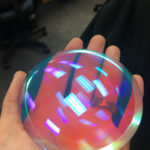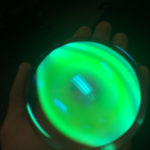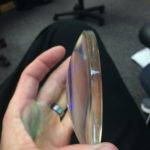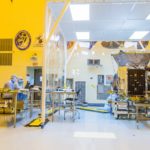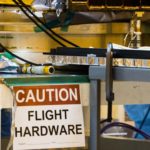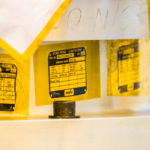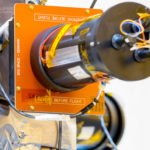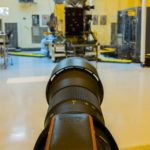

Lifestyle
Going inside NASA’s Clean Room for a rare look at a SpaceX payload
NASA invited media to a very special opportunity to go inside their Clean Room at the Kennedy Space Center in Florida. This is where satellites are meticulously prepared in the weeks leading up to their scheduled launch date. Of course, I was there, I wouldn’t miss this for the world!
The Press Accreditation Office is an unassuming building that’s located off the beaten path and a few miles outside KSC gates. It’s a convenient location for a large gathering of people that need to avoid traffic congestion. The building itself looks like an abandoned gas station without pumps, mostly vacant inside, except for a couple of tables and bathrooms. There’s really nothing inside – not even a coffee maker (I’m shocked by this). It serves its purpose perfectly though – get media personnel checked in and loaded onto a bus, quickly.
I was anxious to go inside NASA’s Clean Room and catch a glimpse of SpaceX’s upcoming payload.
The payload and our Solar System’s latest remote camera is called ‘TESS’ – The Transiting Exoplanet Survey Satellite. Technically speaking, it is a NASA Astrophysics Explorer mission designed to perform an all-sky survey to detect transiting planets around the closest brightest stars by monitoring their brightness with high precision. Simply put, it’s a satellite containing four insanely great cameras that will photograph the sky and detect planets around nearby stars!
After passing through the usual K-9 unit sniff test, I boarded a NASA bus and was taken through parts of the Kennedy Space Center that you don’t ever see while on the standard tour. We were traveling through heavily wooded back-of-the-property roads and for good reason. We were going to NASA’s Payload Hazardous Servicing Facility.
We were first escorted into the conference room, which is separated from the building containing the Clean Room. A bunch of swag-bags for press were being handed out, one for each of us, as we walked inside. The room was furnished with a large board-table with a huge flat-screen TV attached to the wall at the head of the table. Hanging on the walls were stunning high-resolution black and white prints of planets and moons, the same ones you’ve seen on the internet, evenly separated and precisely level. TESS mission experts were sitting at the table waiting for us to take our seats. As I sat down, I noticed some hardware on the table that we would soon be able to get our hands on.
- TESS Principal Investigator, George Ricker beginning the lecture.
- TESS experts waiting for us to take our seats before starting the lecture. (Photo/TomCross)
MIT’s George Ricker – TESS’ Principal Investigator promptly started his lecture about the details of the satellite and the mission. This would be my first MIT-level lecture and I was absolutely captivated because it was organized and explained logically. George is an excellent teacher, very articulate in his descriptions of everything and had the help of great animations on the screen.
You know that scene in Interstellar where the main characters stumble into ‘NASA’ and they’re given a lecture on the ‘anomaly’ that was discovered in our solar system? That’s the scene here, except this was reality – we are discovering distant planets around other Sun’s.

The scene from Interstellar that resembled the TESS lecture.
(Screencap credit : Nolan, C., Nolan, J., Thomas, E., Obst, L. R., McConaughey, M., Hathaway, A., Chastain, J., … Warner Home Video (Firm),. (2015). Interstellar.
There are a ton of impressive features of TESS that I can hardly pick a favorite to tell you about. It has four custom-made high-resolution cameras. The CCD’s (camera sensors) are the largest and most perfect sensors that have ever been developed for a spacecraft. The experts, luckily, had one extra sensor to pass around for us to get a hands-off, drool-worthy close-up look. If you know about full frame 35mm sensors – get a load of this one!
Next up was one of the extra lens-elements that are inside each of the four cameras. I keep a lens cloth in my pocket so once I received it I gave it a soft wipe-down and captured a few iPhone pictures of the different reflections in the lens coating. I’m still hoping for an answer about what this lens is coated with but I may never find out, though. But isn’t it intriguing?
- I’m holding in my hand a lens-element that is inside one of the 4 cameras on TESS. Notice the red color of the coating. (Photo/TomCross)
- The same side of the lens, tilted slightly produces a green color on the coating. (Photo/TomCross)
- Lens held from the side, you can see the serial number etched on the edge and the coating seems clear. (Photo/TomCross)
- The backside of the lens, has a red-yellow hue. (Photo/TomCross)
- Split Diagram of a single TESS camera. (Photo from TESS PDF File)
Perhaps my favorite part of the lecture was learning about how they’re getting this satellite into orbit. This is where orbital dynamics becomes a bit like mixed martial arts with Newton’s laws of motion.
TESS is launching aboard a SpaceX Falcon 9 with a very slim window of opportunity – about 1 minute per day because it has to be perfectly in sync with the orbit of our Moon. As George Ricker explained, “This is a type of orbit that is normally unstable. If you aren’t careful about the way you launch into this orbit, you’re almost guaranteed to hit the Moon within four years. So, there’s a delicate balance staying in this orbit and there’s been a lot of effort that has gone into figuring it out. If you actually manage to do this, it’s stable for decades!”
After transporting into space from Cape Canaveral, via a SpaceX Falcon 9 rocket, the satellite is going to orbit Earth three times, and during each of its closest approaches, the satellite’s hydrazine propulsion system is going to propel it faster, essentially pumping the orbit farther out until it reaches the distance of the Moon. They timed this approach perfectly so that TESS does a ‘lunar flyby’ that will swoop beneath the Moon and use its gravity to speed-up the spacecraft and change its inclination from an East to West orbit to a new North to South orbit the will travel above and below Earth and Moon.
The reason this orbit is so elegantly chosen is that there are 300-hours of unbroken observations for photography, almost non-existent Earth-Moon light pollution. The lens hoods, also, don’t have to deal with much light or toxic radiation levels that will often destroy electronics, thus being able to remain in this orbit for several decades without any help. Absolutely awesome.
So, let’s go see TESS in the clean room.

Bunny-suit selfie!
I was transported to a very tall building and put into a small group to get dressed into bunny-suits before entering the high-bay, Clean Room. They take ‘clean’ seriously. Before stepping into the dressing room, I was escorted to a shoe scrubbing machine that had large scrubby-wheels and a vacuum to capture the particles. Then, to another device that automatically put booties on my shoes.
As I walked into the clean room, there was a sticky doormat that grabbed any particles off my booties that I picked up on the way in. I was quickly fitted with a bunny suit “You look like a large, here you go,” said a facility employee while handing me a sealed bag with a clean suit inside. We were shown how to put the suit on. Then, we went over to the glove dispensary to be sized. I noticed that their gloves were incorrectly labeled S, M, and L, according to NASA lore. I asked the employees, “Do you know about the issue this caused with the condom sizes astronauts chose?” They did not. So I was able to teach the workers a fun-fact about astronauts.
See, astronauts have egos, all of them contain the ‘Right Stuff’ but not all of them wear the same sized condoms for their spacesuit urine bags. All astronauts chose ‘Large’, not wanting to hurt their egos. Sometimes their urine condoms leaked into their spacesuit so NASA came up with a brilliant plan: Change the names of the condoms from Small, Medium, and Large to Large, Huge, and Gigantic so that all astronauts chose their appropriate sizes. It worked! But, in this case, the gloves were not labeled this way. Of course, I asked for Large. The room burst into laughter.
An employee handed me an alcohol-soaked microfiber cloth and told me to wipe down my gear perfectly before going to the next cleaning-station. This was followed by a visit to an ‘Air Shower’. It’s literally what it sounds like. There’s a small rectangular-shaped room with nozzles on the ceiling and walls that eject high-powered air all over our body. Vents in the floor sucked particles through a filter. After this final cleanse, we were checked with a blacklight … ok, just kidding. After the air shower we were granted access to the room that TESS was located: NASA’s high-bay!
The room was absolutely drenched in disorienting orange sodium lighting – a nightmare to deal with for photography and white balance but TESS was in its own protected E.T. style clean area beneath bright fluorescent lights.
In the limited time available, we were able to interview satellite experts and take as many photos as we could while technicians worked on the satellite. I love hardware images, so I set up my tripod and used my Miops Mobile remote to photograph detailed close-ups of the intricate components.

Wide angle image of the high-bay, TESS inside its own clean-room. (Photo/TomCross)
I was politely warned to not take any photographs of the hardware surrounding the satellite and keep my lens pointed only at the satellite in order to not accidentally capture something I’m not supposed to. I was very respectful and got some incredible images of things you typically will never see unless you worked on it yourself.
The spacecraft itself is quite small, there’ll be plenty of room remaining in the Falcon 9 fairing.
- TESS work environment. (Photo/TomCross)
- An Engineering working on TESS. (Photo/TomCross)
- Closeup of Orbital ATK data stickers. (Photo/TomCross)
- I used Miops Mobile remote to get clear images with slow shutter speeds inside the Clean Room. (Photo/TomCross)
It’s not often I get to see a payload inside a NASA Clean Room. These are always incredible experiences.
Frequently, a mission’s importance is diminished by the fact that we’re unable to see what’s going to space and what its purpose is, mainly weather and communications satellites. They often have state-of-the-art technology on board, which is likely the reason why they want to keep it under wraps. I’m really looking forward to photographing this launch in April now that I have actually seen the payload in person.
After my time was up photographing TESS, I changed out of the bunny-suit and was brought back to the Accreditation Office. I wasted no time getting on my way to see Falcon Heavy’s Side Booster that was temporarily on display at Kennedy Space Center Visitor’s Center.

A beautiful sunset eclipsed by SpaceX’s equally beautiful flight-proven Falcon Heavy booster. (Tom Cross/Teslarati)
Have a good one,
Tom Cross
Lifestyle
EV fans urge Tesla to acquire Unplugged Performance for edge in fleet and security industry
Unplugged Performance has built a name for itself by producing performance upgrades for Tesla vehicles.

A growing number of Tesla enthusiasts and longtime community voices are calling on the electric vehicle maker to acquire Unplugged Performance, a California-based aftermarket company best known for tuning Tesla vehicles and developing specialized government fleet solutions under its UP.FIT division.
The idea was once considered a niche proposal among EV fans, but it is now gaining serious attention not just as a performance play but as a strategic move to deepen Tesla’s roots in the fleet and security industry.
A strategic fit
Unplugged Performance has built a name for itself by producing performance upgrades for Tesla vehicles, from track-optimized components to visual and aerodynamic upgrades. But in recent years, its UP.FIT division has pivoted toward a more functional future by outfitting Tesla vehicles like Model Ys for police, military, and government use.
That work has sparked growing calls for closer collaboration with Tesla, especially as the EV maker increasingly leans into autonomy, AI, and fleet services as core components of its next chapter.
“I posted this four years ago, but I think it’s more true now than ever,” wrote Whole Mars Catalog, a well-known Tesla investor and FSD Beta tester, on X. “Tesla should buy Unplugged. But not just as a Performance division. What they are doing with UP.FIT unlocks large government and commercial fleet purchases that can improve utilization.”
Tesla fans such as shareholder Sawyer Merritt echoed the sentiment, calling Unplugged a “great fit within Tesla.” adding, “They are literally located directly next to Tesla’s design studio in Hawthorne.”
Enabling the next wave
Supporters of the idea noted that integrating Unplugged into Tesla’s corporate structure could help accelerate the adoption of autonomous technologies in government sectors. With UP.FIT patrol cars already in use across some U.S. police departments, Tesla fans envisioned a future where self-driving Teslas could potentially revolutionize law enforcement, search-and-rescue, and public service logistics.
“Just imagine how autonomous patrol cars could transform policing and bring us into a safer future,” the veteran FSD tester wrote.
The benefits could also extend to Tesla’s existing consumer base. “They also have some incredible products in the works that I think will appeal to many ordinary Tesla drivers — not just those looking for performance or mods. Stuff that’s so good it should have come straight from the design studio next door,” Whole Mars Catalog noted.
Unplugged Performance, founded in 2013, shares not just a product vision with Tesla, but also geography. Its Hawthorne headquarters sits directly adjacent to Tesla’s design studio, and the two companies have maintained a close working relationship over the years. The aftermarket firm has long positioned itself as a “mission-aligned” partner to Tesla.
In response to the recent calls for acquisition, Unplugged Performance acknowledged the support from the community. “Our very existence is to support the Tesla mission with @UpfitTesla and @UnpluggedTesla,” Unplugged CEO Ben Schaffer posted on X. “We love working with Tesla and are grateful for the community’s support since 2013!”
Elon Musk
X account with 184 followers inadvertently saves US space program amid Musk-Trump row
Needless to say, the X user has far more than 184 followers today after his level-headed feat.
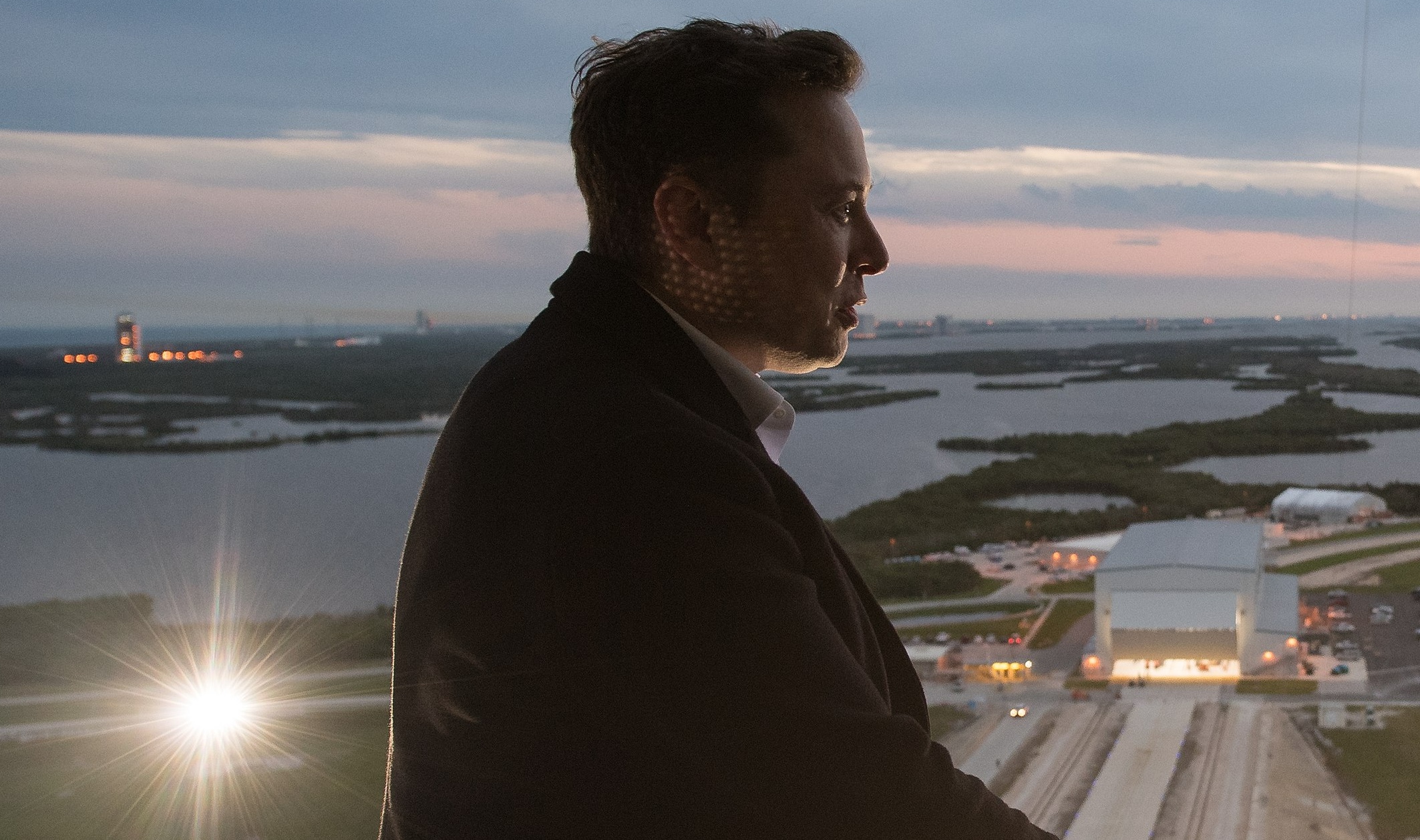
An X user with 184 followers has become the unlikely hero of the United States’ space program by effectively de-escalating a row between SpaceX CEO Elon Musk and President Donald Trump on social media.
Needless to say, the X user has far more than 184 followers today after his level-headed feat.
A Near Fall
During Elon Musk and Donald Trump’s fallout last week, the U.S. President stated in a post on Truth Social that a good way for the United States government to save money would be to terminate subsidies and contracts from the CEO’s companies. Musk responded to Trump’s post by stating that SpaceX will start decommissioning its Dragon spacecraft immediately.
Musk’s comment was received with shock among the space community, partly because the U.S. space program is currently reliant on SpaceX to send supplies and astronauts to the International Space Station (ISS). Without Dragon, the United States will likely have to utilize Russia’s Soyuz for the same services—at a significantly higher price.
X User to the Rescue
It was evident among X users that Musk’s comments about Dragon being decommissioned were posted while emotions were high. It was then no surprise that an X account with 184 followers, @Fab25june, commented on Musk’s post, urging the CEO to rethink his decision. “This is a shame this back and forth. You are both better than this. Cool off and take a step back for a couple days,” the X user wrote in a reply.
Much to the social media platform’s surprise, Musk responded to the user. Even more surprising, the CEO stated that SpaceX would not be decommissioning Dragon after all. “Good advice. Ok, we won’t decommission Dragon,” Musk wrote in a post on X.
Not Planned, But Welcomed
The X user’s comment and Musk’s response were received extremely well by social media users, many of whom noted that @Fab25june’s X comment effectively saved the U.S. space program. In a follow-up comment, the X user, who has over 9,100 followers as of writing, stated that he did not really plan on being a mediator between Musk and Trump.
“Elon Musk replied to me. Somehow, I became the accidental peace broker between two billionaires. I didn’t plan this. I was just being me. Two great minds can do wonders. Sometimes, all it takes is a breather. Grateful for every like, DM, and new follow. Life’s weird. The internet’s weirder. Let’s ride. (Manifesting peace… and maybe a Model Y.)” the X user wrote.
Lifestyle
Tesla Cybertruck takes a bump from epic failing Dodge Charger
The Cybertruck seemed unharmed by the charging Charger.
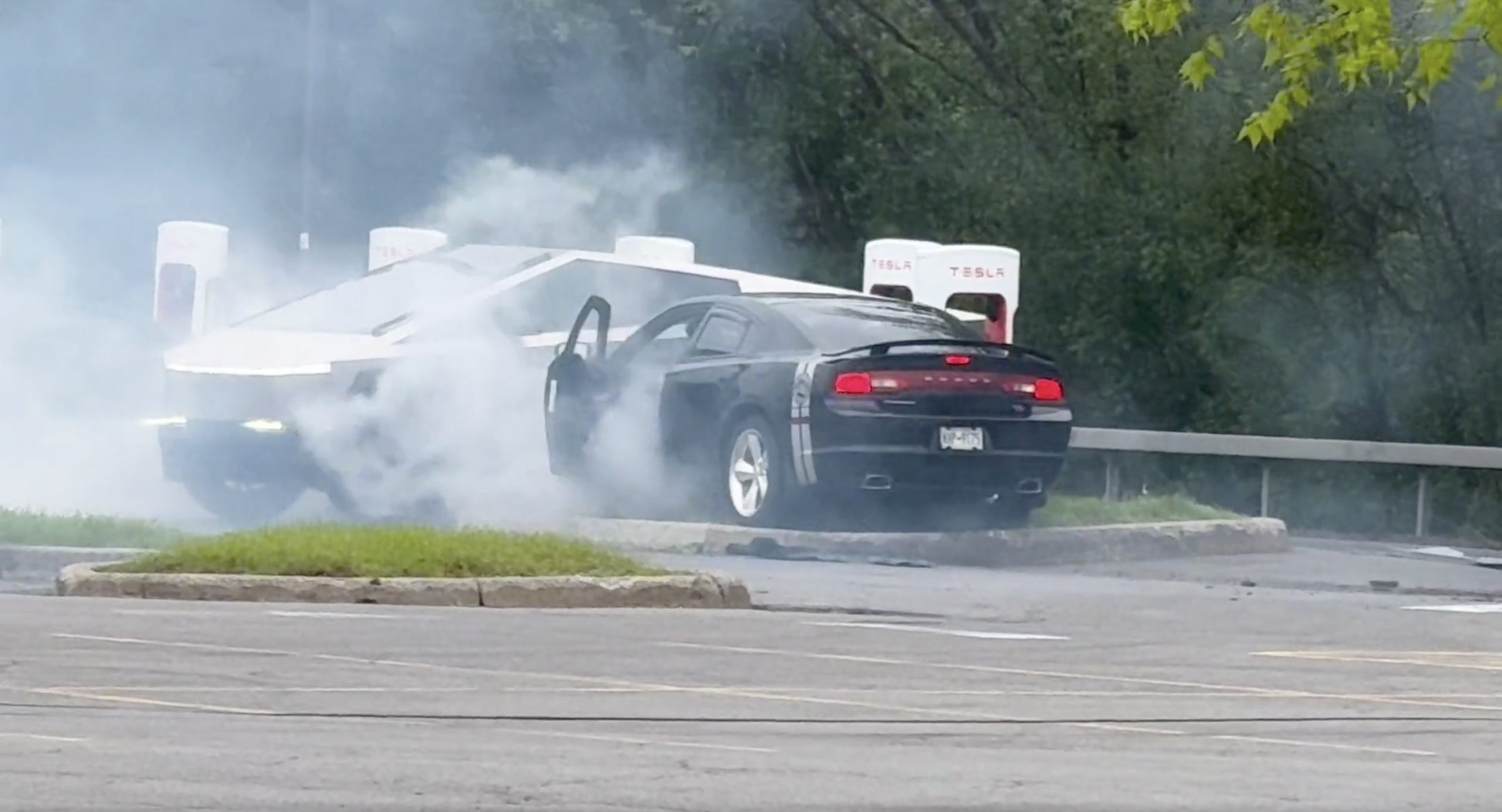
There comes a time in a driver’s life when one is faced with one’s limitations. For the driver of a Dodge Charger, this time came when he lost control and crashed into a Tesla Cybertruck–an absolute epic fail.
A video of the rather unfortunate incident was shared on the r/TeslaLounge subreddit.
Charging Charger Fails
As could be seen in the video, which was posted on the subreddit by Model Y owner u/Hammer_of_something, a group of teens in a Dodge Charger decided to do some burnouts at a Tesla Supercharger. Unfortunately, the driver of the Charger failed in his burnout or donut attempt, resulting in the mopar sedan going over a curb and bumping a charging Cybertruck.
Ironically, the Dodge Charger seemed to have been parked at a Supercharger stall before its driver decided to perform the failed stunt. This suggests that the vehicle was likely ICE-ing a charging stall before it had its epic fail moment. Amusingly enough, the subreddit member noted that the Cybertruck did not seem like it took any damage at all despite its bump. The Charger, however, seemed like it ran into some trouble after crashing into the truck.
Alleged Aftermath
As per the the r/TeslaLounge subreddit member, the Cybertruck owner came rushing out to his vehicle after the Dodge Charger crashed into it. The Model Y owner then sent over the full video of the incident, which clearly showed the Charger attempting a burnout, failing, and bumping into the Cybertruck. The Cybertruck owner likely appreciated the video, in part because it showed the driver of the Dodge Charger absolutely freaking out after the incident.
The Cybertruck is not an impregnable vehicle, but it can take bumps pretty well thanks to its thick stainless steel body. Based on this video, it appears that the Cybertruck can even take bumps from a charging Charger, all while chilling and charging at a Supercharger. As for the teens in the Dodge, they likely had to provide a long explanation to authorities after the incident, since the cops were called to the location.
-

 News3 days ago
News3 days agoTesla debuts hands-free Grok AI with update 2025.26: What you need to know
-

 Elon Musk1 week ago
Elon Musk1 week agoElon Musk confirms Grok 4 launch on July 9 with livestream event
-

 Elon Musk5 days ago
Elon Musk5 days agoxAI launches Grok 4 with new $300/month SuperGrok Heavy subscription
-

 News2 weeks ago
News2 weeks agoTesla Model 3 ranks as the safest new car in Europe for 2025, per Euro NCAP tests
-

 Elon Musk2 weeks ago
Elon Musk2 weeks agoxAI’s Memphis data center receives air permit despite community criticism
-

 News5 days ago
News5 days agoTesla begins Robotaxi certification push in Arizona: report
-

 Elon Musk2 weeks ago
Elon Musk2 weeks agoTesla reveals it is using AI to make factories more sustainable: here’s how
-

 Elon Musk2 weeks ago
Elon Musk2 weeks agoTesla scrambles after Musk sidekick exit, CEO takes over sales





